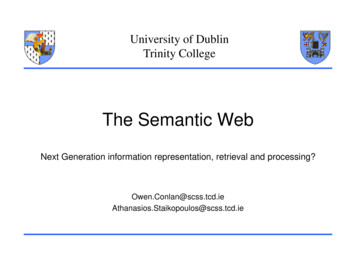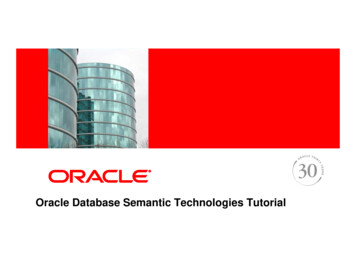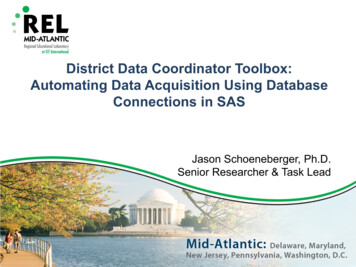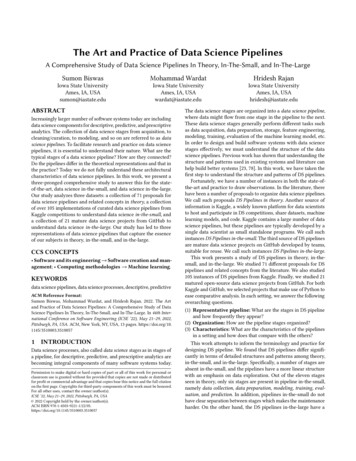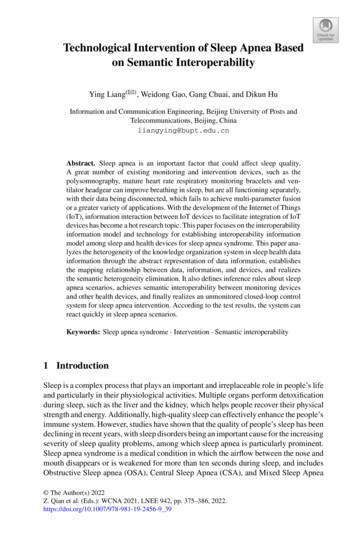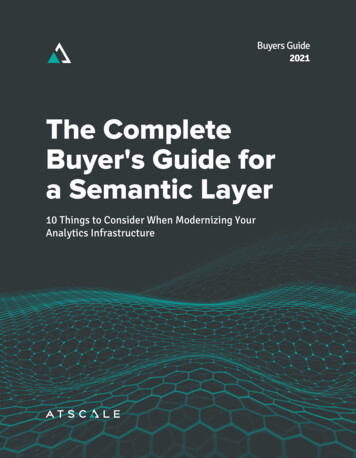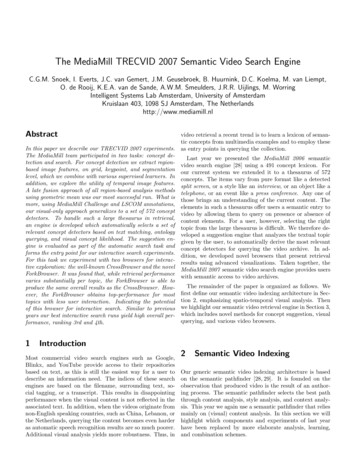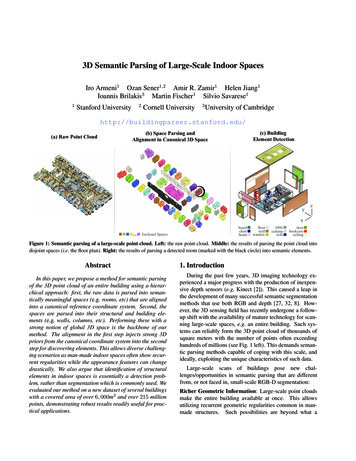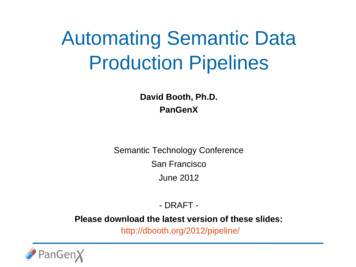
Transcription
Automating Semantic DataProduction PipelinesDavid Booth, Ph.D.PanGenXSemantic Technology ConferenceSan FranciscoJune 2012- DRAFT Please download the latest version of these slides:http://dbooth.org/2012/pipeline/
Speaker background David Booth, PhD:– Software architect, PanGenX– Cleveland Clinic 2009-2010– HP Software & other companies prior– Focus on semantic web architecture and technology2
PanGenX: Enabling personalized medicine Pharmacogenetics is key Knowledge-as-a-Service A proprietary, scalable knowledgebase, analyticsengine, and decision-support tool Cloud accessible Suitable for many applications Customizable for each therapeutic area3
Architectural strategy for semantic dataintegration1. Data production pipeline– E.g., Genomic, phenotypic, drug, patientrecords, outcomes, etc.2. Use RDF in the middle; Convert to/from RDF atthe edges– Good for integration, inference andcontext/provenance (with named graphs)3. Use ontologies and rules for semantictransformations– SPARQL is convenient as a rules language4
What is the RDF Pipeline Framework? Framework for automated data production pipelines Intended for big data integration Designed for RDF, but data agnostic Open source – Apache 2.0 licenseNot: A universal data model approach A workflow language– No flow-of-control operators5
Major features Distributed, decentralized Loosely coupled– Based on RESTful HTTP Easy to use– No API calls (usually) Efficient– Automatic caching– Dependency graph avoids unnecessary data regeneration Programming language agnosticCaveat: Still in development. No official release yet.6
Example yimmunology Pipeline: set of nodes in a data flow graph Nodes process and store data7
Example pipeline definition (in Turtle)1.@prefix p: http://purl.org/pipeline/ont# .2.@prefix : http://localhost/node/ .3.:patients a p:FileNode .4.:labs a p:FileNode .5.:normalize a p:FileNode ;6.7.8.9.10.p:inputs ( :labs ) .:merge a p:FileNode ;p:inputs ( :patients :normalize ) .:process a p:FileNode ;p:inputs ( :merge ) .11.:cardiology a p:FileNode ;12.p:inputs ( :process ) .13.14.:immunology a p:FileNode ;p:inputs ( :process ) .8
Related work Linked Data Integration Framework (LDIF)– “Translates heterogeneous Linked Data from the Web”– http://www4.wiwiss.fu-berlin.de/bizer/ldif/– Similarities: Pipeline framework for RDF data– Differences: Central control; Synchronous; Hadoop; Oriented toward Linked Data Sparql Motion, from Top Quadrant– A “visual scripting language for semantic data processing”– tml– Similarities: Easy to visualize; Easy to build a pipeline– Differences: Central control & execution; Not cache oriented DERI Pipes– A “paradigm to build RDF-based mashups”– http://pipes.deri.org/– Similarities: Very similar goals– Differences: XML pipeline definition; Central control; Not cache oriented Hadoop– Implementation of map-reduce algorithm– http://hadoop.apache.org/– Similarities: Distributed data production– Differences: Much more mature; For parallelizing big data analysis; Java based Oozie– “Workflow/coordination service to manage data processing jobs for Apache Hadoop ”– http://rvs.github.com/oozie/index.html9
Related work (cont.) NetKernel– An “implementation of the resource oriented computing (ROC)” – think REST– http://www.1060research.com/netkernel/– Similarities: Based on REST (REpresentation State Transfer)– Differences: Lower level; Expressed through programming language bindings (Java, Python, etc.)instead of RDF Propagators, by Gerald Jay Sussman and Alexey Radul– Scheme-based programming language for propagating data through a network– ors/revised-html.html– Similarities: Auto-propagation of data through a network– Differences: Programming language; Finer grained; Uses partial evaluation; Much larger paradigm shift Enterprise Service Bus (ESB)– http://soa.sys-con.com/node/48035#– Similarities: Similar problem space– Differences: Central messaging bus and orchestration; Heavier weight; SOA, WS*, XML oriented;Different cultural background Extract, Transform, Load (ETL)– http://www.pentaho.com/– Similarities: Also used for data integration– Differences: Central orchestration and storage; Oriented toward lower level format transformations10
Why a data production pipeline?11
Problem 1: Multiple, diverse data sourcesTo ntologies& Rules Different technologies, protocols and vocabularies Solution:– Convert to RDF at the edges– Use ontologies and rules to transform to hub ontology12
Problem 2: Multiple, diverse derationOntologiesOntologies&&RulesRulesFrom RDFTo RDFAZ Often must support multiple, diverse data sinks Solution:– Use ontologies and rules to transform to presentation ontologies– Convert from RDF at the edges13
Problem 3: Evolving sFrom RDFTo RDFYZ New data sources and sinks get added Transformations get complex, involve several steps Solution: Data pipeline . . .14
Conceptual data taIntegrationFederationFrom RDFTo Ontologies&&Rules&RulesRulesZimmunology Pipeline: set of nodes in a data flow graph Nodes process and store data But the reality is often different . . .15
Data pipeline (ad unology Typically involves:– Mix of technologies: shell scripts, SPARQL, databases,web services, etc.– Mix of formats – RDF, relational, XML, etc.– Mix of interfaces: Files, WS, HTTP, RDBMS, etc.16
Problem 4: Ad hoc pipelines are hard to 11-janreport-2011-feb Pipeline topology is implicit, deep in code– Often spread across different computers Hard to get the “big picture” Complex & fragile Solution: Pipeline language / framework17
Pipeline using a pipeline gyimmunology Pipeline is described explicitly Framework runs the pipeline Easy to visualize – generate a picture! Easy to see dependencies Easier to maintain18
Problem 5: Diverse processing needsNode ANode B Nodes perform arbitrary processing RDF is not the only tool in your toolbox Diverse data objects: RDF graphs, files, relational tables,Java object, etc. Diverse processing languages: Java, shell, SPARQL, etc. Need to choose the best tool for the job Solution: Node wrappers19
Node wrappers and updatersNode ANode BWrapperWrapperUpdaterlogic for AUpdaterlogic for B Node consists of:– Wrapper – supplied by framework (or add your own)– Updater – your custom code Wrapper handles:– Inter-node communication– Updater invocation Updater can use any kind of data object or programminglanguage, given an appropriate wrapper20
Example pipeline definition (in Turtle)1.@prefix p: http://purl.org/pipeline/ont# .2.@prefix : http://localhost/node/ .3.:patients a p:FileNode .4.:labs a p:FileNode .5.:normalize a p:FileNode ;6.7.8.9.10.p:inputs ( :labs ) .:merge a p:FileNode ;p:inputs ( :patients :normalize ) .:process a p:FileNode ;p:inputs ( :merge ) .11.:cardiology a p:FileNode ;12.p:inputs ( :process ) .13.14.Wrapper:immunology a p:FileNode ;p:inputs ( :process ) .21Updater
Basic wrappers FileNode– Updater is a command that generates a file– E.g., shell script GraphNode– Updater is a SPARQL Update operation that generates an RDFnamed graph– E.g., INSERT JavaNode– Updater is a Java class that generates a Java objectOther wrappers can also be plugged in, e.g., Python, MySql,etc.22
Problem 6: Unnecessary data ate!mergeprocesscardiologyimmunology Wasteful and slow to re-run the entire pipeline whenonly one branch changed Solution: Use the dependency graph!23
Avoiding unnecessary data ologyimmunology Data is automatically cached at every node Pipeline framework updates only what needs to beupdated– Think “Make” or “Ant”, but distributed Updater stays simple24
Problem 7: When should a node be iologyimmunology Whenever any input changes? (Eager) Only when its output is requested? (Lazy) Trade-off: Latency versus processing time Solution: Update policy25
Update policy Controls when a node's data is updated:– Lazy – Only when output is requested– Eager – Whenever the node's input changes– Periodic – Every n seconds– EagerThrottled – When an input changes but not faster thanevery n seconds– Etc. Handled by wrapper – independent of updater– Updater code stays simple – unpolluted26
Specifying an update policy4.5.:normalize a p:FileNode ;6.p:updatePolicy p:eager ;7.p:inputs ( :labs ) .8.27
Problem 8: Distributing the ix p: http://purl.org/pipeline/ont# .2.@prefix b1: http://server1/ .3.@prefix b2: http://server1/ .4.b1:bookStore1 a p:JenaNode .5.b2:bookStore2 a p:JenaNode ;6.p:inputs ( b1:bookStore1 ) .28Sameserver
Distributed @prefix p: http://purl.org/pipeline/ont# .2.@prefix b1: http://server1/ .3.@prefix b2: http://server2/ .4.b1:bookStore1 a p:JenaNode .5.b2:bookStore2 a p:JenaNode ;6.p:inputs ( b1:bookStore1 ) .29Differentserver
Problem 9: Efficiently scaling for big dataAB Problem: Big datasets take too long to generate– Wasteful to regenerate when only one portion is affected Observation: Big datasets can often be naturallysubdivided into relatively independent chunks, e.g.:– Patient records in hospital dataset Solution: Map operatorCaveat: Not yet implemented!30
Generating one graph collection from anotherABB map(f, A)a1f(a1)f(a2)a2a3a4f(a3)f(a4)b1b2b3b4 A and B contain a large number of items (chunks) Each item in B corresponds to one item in A The same function f creates each bi from ai:– foreach i, bi f(ai)31
Benefits of map operatorAa1f(a1)f(a2)a2a3a4BB map(f, A)f(a3)f(a4)b1b2b3b4 Work can be distributed across servers Framework only updates chunks that need to be updated Updater stays simple:– Only needs to know now to update one chunk– Unpolluted by special API calls32
Pipeline definition using map operatorAB1.@prefix p: http://purl.org/pipeline/ont# .2.@prefix : http://localhost/ .3.:A a p:FileNode .4.:B a p:FileNode ;5.p:inputs ( ( p:map :A ) ) ;6.p:updater "B-updater" .33
Problem 10: Optimizing local communicationEnv 1: RDF storewHTTPEnv 2: File systemxHTTPyHTTP Communication defaults to RESTful HTTP Inefficient to use HTTP between local objects, e.g.:– Files on the same server– Named graphs in the same RDF store– Java objects in the same JVM34z
Physical pipeline communication: efficiencyEnv 1: RDF storewNativeprotocolEnv 2: File systemxHTTPyNativeprotocolz Solution: Framework uses native protocols betweenlocal objects Wrappers automatically:– Use native protocols within an environment– Use HTTP between environments Updater stays simple: always thinks it's talking locally35
DEMO36
Demo immunology37
Demo URLs http://localhost/node/patients http://localhost/node/labs http://localhost/node/normalize http://localhost/node/merge http://localhost/node/cardiology http://localhost/node/immunology 38
Problem 11: How to indicate what data gyimmunologyWantspatient (003 006) immunology only needs a subset of process Wasteful to generate all possible records How can immunology tell process which records it wants?39
Solution: Propagate parameters nt (002,003,004)processcardiologyParameters:patient (003,006)immunology Patient ID parameters are passed upstream40
Merging ient (002,003,004,006)Parameters:patient (002,003,004)processcardiologyParameters:patient (003,006)immunology41
Passing different parameters to different inputslabspatientsnormalizeParameters:patient (002,003,004,006)mergeParameters:customer (002,003,004,006)Parameters:patient (002,003,004,006)processcardiologyimmunology Different inputs may need different parameters Node's p:parametersFilter can transform parameters42
DEMO43
Demo URLs http://localhost/node/patients http://localhost/node/labs http://localhost/node/normalize http://localhost/node/merge http://localhost/node/cardiology http://localhost/node/immunology http://localhost/node/cardiology?id (002,003,004) http://localhost/node/immunology?id (003,006) 44
Summary Efficient– Updates only what needs to be updated– Caches automatically– Communicates with native protocols when possible, RESTfulHTTP otherwise Flexible:– Any kind of data – not only RDF– Any kind of custom code (using wrappers) Easy:– Easy to implement nodes (using standard wrappers)– Easy to define pipelines (using a few lines of RDF)– Easy to visualize– Easy to maintain – very loosely coupled45
Questions?46
BACKUP SLIDES47
Wrappers and updaters (in Turtle)With implicit updater:1. . . .2. :normalize a p:FileNode ;3.p:inputs ( :labs ) .WrapperUpdater4. . . .48
Wrappers and updaters (in Turtle)With implicit updater:1. . . .Wrapper2. :normalize a p:FileNode ;3.p:inputs ( :labs ) .Updater4. . . .With explicit updater:5. . . .Wrapper6. :normalize a p:FileNode ;7.p:inputs ( :labs ) ;8.p:updater "normalize-updater" .9. . . .49Updater
Terminology: output versus parametersParametersNode COutput Output flows downstream Parameters flow upstream50Node D
Example one-node pipeline definition:“hello world”hello1. @prefix p: http://purl.org/pipeline/ont# .2. @prefix : http://localhost/ .3. :hello a Node ;4.p:updater "hello-updater" .Output can be retrieved from http://localhost/hello51
Implementation of “hello world” NodeCode in hello-updater:1.#!/bin/bash p2.echo Hello from 1 on date hello-updater is then placed where the wrapper canfind it– E.g., Apache WWW directory52
Invoking the “hello world” NodeWhen URL is accessed:http://localhost/helloIf cacheFile is stale, wrapper invokes the updater as:hello updater cacheFileWrapper serves cacheFile content:Hello on Wed Apr 13 14:54:57 EDT 201153
What do I mean by “cache”? Meaning 1: A local copy of some other data store– I.e., the same data is stored in both places Meaning 2: Stored data that is regenerated when stale– Think: caching the results of a CGI program– Results can be served from the cache if inputs have notchanged54
Example pipeline: sum two numbersaasumbbPipeline definition:1.@prefix p: http://purl.org/pipeline/ont.n3# .2.@prefix : http://localhost/ .3.:aa a p:Node .4.:bb a p:Node .5.:sum a p:Node ;6.p:inputs ( :aa :bb ) ;7.p:updater "sum updater" .55
sum-updater implementationaasumbbNode implementation (in Perl):1.#! /usr/bin/perl w2.# Add numbers from two nodes.3.my sum cat ARGV[1] cat ARGV[2] ;4.print " sum\n";aa cache56bb cache
Why SPARQL? Standard RDF query language Can help bridge RDF -- relational data– Relational -- RDF: mappers are heArt– RDF -- relational: SELECT returns a table Also can act as a rules language– CONSTRUCT or INSERT57
SPARQL CONSTRUCT as an inference rule CONSTRUCT creates (and returns) new triples if acondition is met– That's what an inference rule does! CONSTRUCT is the basis for SPIN (Sparql InferenceNotation), from TopQuadrant However, in standard SPARQL, CONSTRUCT onlyreturns triples (to the client)– Returned triples must be inserted back into the server – anextra client/server round trip58
SPARQL INSERT as an inference rule INSERT creates and asserts new triples if a condition is met– That's what an inference rule does! Single operation – no need for extra client/server round trip Issue: How to apply inference rules repeatedly until no new facts areasserted?– E.g. transitive closure– cwm --think option– SPIN In standard SPARQL, requested operation is only performed once Would be nice to have a SPARQL option to REPEAT until no newtriples are asserted59
SPARQL bookStore2 INSERT example1. # Example from W3C SPARQL Update 1.1 specification2. #3. PREFIX dc: http://purl.org/dc/elements/1.1/ 4. PREFIX xsd: http://www.w3.org/2001/XMLSchema# 5.6. INSERT7. { GRAPH http://example/bookStore2 { ?book ?p ?v } }8. WHERE9. { GRAPH http://example/bookStore1 10.{ ?book dc:date ?date .11.FILTER ( ?date "1970-01-01T00:00:00-02:00" xsd:dateTime )12.?book ?p ?v13. } }60
BookStore2 INSERT rule as pipeline1. # Example from W3C SPARQL Update 1.1 specification2. #:bookStore2:bookStore3. PREFIX dc: http://purl.org/dc/elements/1.1/ Usually several rules would4. PREFIX NOTE:xsd: http://www.w3.org/2001/XMLSchema# be used in each pipeline stage5.6. INSERT7. { GRAPH http://example/bookStore2 { ?book ?p ?v } }8. WHERE9. { GRAPH http://example/bookStore1 10.{ ?book dc:date ?date .11.FILTER ( ?date "1970-01-01T00:00:00-02:00" xsd:dateTime )12.?book ?p ?v13. } }61
BookStore2 pipeline definition1.@prefix p: http://purl.org/pipeline/ont# .2.@prefix : http://localhost/ .3.:bookStore1 a p:JenaNode .4.:bookStore2 a p:JenaNode ;5.p:inputs ( :bookStore1 ) ;6.p:updater “bookStore2-updater.sparql” .62
SPARQL INSERT as a reusable rule:bookStore2-updater.sparql1. # output will be the named graph for the rule's results2. # input1 will be the input named graph3. PREFIX dc: http://purl.org/dc/elements/1.1/ 4. PREFIX xsd: http://www.w3.org/2001/XMLSchema# 5.6. INSERT7. { GRAPH http://example/bookStore2 { ?book ?p ?v } }8. WHERE9. { GRAPH http://example/bookStore1 10.{ ?book dc:date ?date .11.FILTER ( ?date "1970-01-01T00:00:00-02:00" xsd:dateTime )12.?book ?p ?v13. } }63
SPARQL INSERT as a reusable rule:bookStore2-updater.sparql1. # output will be the named graph for the rule's results2. # input1 will be the input named graph3. PREFIX dc: http://purl.org/dc/elements/1.1/ 4. PREFIX xsd: http://www.w3.org/2001/XMLSchema# 5.6. INSERT7. { GRAPH output{ ?book ?p ?v } }8. WHERE9. { GRAPH10. input1{ ?book dc:date ?date .11.FILTER ( ?date "1970-01-01T00:00:00-02:00" xsd:dateTime )12.?book ?p ?v13. } }64
Issue: Need for virtual graphs How to query against a large collection of graphs? Some graph stores query the merge of all namedgraphs by default– Virtual graph or “view”– sd:UnionDefaultGraph feature BUT it only applies to the default graph of the entiregraph store Conclusion: Graph stores should support multiplevirtual graphs– Some do, but not standardized65
Rough sketch of pipeline ontology: ont.n3 (1)1.@prefix p: http://purl.org/pipeline/ont# .2.@prefix rdfs: http://www.w3.org/2000/01/rdf schema# .3.4.######### Example Node types ##########5.p:Node a rdfs:Class .6.p:CommandNoderdfs:subClassOf p:Node .7.p:JenaNoderdfs:subClassOf p:Node .8.p:SesameNoderdfs:subClassOf p:Node .9.p:PerlNoderdfs:subClassOf p:Node .10.p:MysqlNode rdfs:subClassOf p:Node .11.p:OracleNoderdfs:subClassOf p:Node .66# Default Node type
Rough sketch of pipeline ontology: ont.n3 (2)12.######### Node properties ##########13.p:inputsrdfs:domain p:Node .14.p:parametersrdfs:domain p:Node .15.p:dependsOnrdfs:domain p:Node .16.17.# p:state specifies the output cache for a node.18.# It is node type specific, e.g., filename for FileNode .19.# It may be set explicitly, otherwise a default will be used.20.p:staterdfs:domain p:Node .21.22.# p:updater specifies the updater method for a Node.23.# It is node type specific, e.g., a script for CommandNode .24.p:updaterrdfs:domain p:Node .25.26.# p:updaterType specifies the type of updater used.27.# It is node type specific.28.p:updaterType rdfs:domain p:Node .67
Rough sketch of pipeline ontology: ont.n3 (3)29.######### Rules ##########13.# A Node dependsOn its inputs and parameters:14.{ ?a p:inputs ?b . } { ?a p:dependsOn ?b . } .15.{ ?a p:parameters ?b . } { ?a p:dependsOn ?b . } .68
Nodes Each node has:– A URI (to identify it)– One output “state”– An update method (“updater”) for refreshing its outputcache A node may also have:– Inputs (from upstream)– Parameters (from downstream)69
(Demo 0: Hello world)70
Example GraphNode pipeline (one node)@prefix p: http://purl.org/pipeline/ont# .@prefix : http://localhost/ .:e a :GraphNode ;p:updater “e-updater.sparql” .71
File example-construct.txt# Example from SPARQL 1.1 specPREFIX foaf: http://xmlns.com/foaf/0.1/ PREFIX vcard: http://www.w3.org/2001/vcard-rdf/3.0# CONSTRUCT { ?x vcard:N :v .:v vcard:givenName ?gname .:v vcard:familyName ?fname }WHERE{{ ?x foaf:firstname ?gname } UNION { ?x foaf:givenname ?gname } .{ ?x foaf:surname ?fname } UNION { ?x foaf:family name ?fname } .}72
(Demo: Sparql INSERT)73
Example 1: Multiple nodesGeneratesnumbers:10, 20, 30, etc.beSelects oddnumbers from ccGeneratesnumbers:1, 2, 3, 4, etc.aSums pairs froma and b:11, 22, 33, etc. Node c consumes records from a & b Nodes d & e consume records from c74dSelects evennumbers from c
Data in node a s01 a1 111 .b s01 a2 121 . s01 a3 131 .ec s02 a1 112 . s02 a2 122 .a s02 a3 132 . s03 a1 113 . s03 a2 123 . s03 a3 133 . s04 a1 114 . s09 a3 139 .75d
Data in node b s01 b1 211 .b s01 b2 221 . s01 b3 231 .ec s02 b1 212 . s02 b2 222 .a s02 b3 232 . s03 b1 213 . s03 b2 223 . s03 b3 233 . s04 b1 214 . s09 b3 239 .76d
Data in node c s01 a1 111 .b s01 a2 121 . s01 a3 131 . s01 b1 211 .Mergedtriples s01 b2 221 . s01 c1 111211 . s01 c2 121221 . s01 c3 131231 .ca s01 b3 231 .Inferredtriples s02 a1 112 . s09 c3 139239 .77ed
Data in nodes d&e: same as c s01 a1 111 .b s01 a2 121 . s01 a3 131 .ec s01 b1 211 . s01 b2 221 .a s01 b3 231 . s01 c1 111211 . s01 c2 121221 . s01 c3 131231 . s02 a1 112 . s09 c3 139239 .78d
Example 2: Multiple node pipeline in N3# Example 1: Multiple nodes@prefix p: http://purl.org/pipeline/ont# .@prefix : http://localhost/ .:a a p:Node .:ap:updater "a-updater" .:b a p:Node .:bp:updater "b-updater" .:c a p:Node .:cp:inputs ( :a :b ) .:cp:updater "c-updater" .:d a p:Node .:dp:inputs ( :c ) .:dp:updater "d-updater" .:e a p:Node .:ep:inputs ( :c ) .:ep:updater "e-updater" .79
(Demo 1: Multiple node pipeline)80
Pipelines and environmentsOne environment:ABCBCBCBCTwo environments:ATwo environments:AThree environments:A Reminder: Environment means server and node type81
Small diagrambecda82
Example: Monthly reportauxiliaryDataParameters:(a1, a5, a8, . . .)baseRecordstransformedAuxDataParameters:(rec01, rec05, rec08, . . .)mergeParameters:(a1, a5, a8, . . .)Parameters:(rec01, rec05, rec08, . . .)processreport-2011-01Parameters:dateMin: 2011-02-01dateMax: 2011-03-01report-2011-02 Downstream reports should auto update whenbaseRecords change83
amergeprocessreport-2011-01report-2011-02 A node's state cache becomes stale if an input node changes– The node's update method must be invoked to refresh it E.g., when baseRecords is updated, merge becomes stale84
Option 3: RDF data pipeline frameworkXAYZB Uniform, distributed, data pipeline framework Custom code is hidden in standard wrappers Pros: Easy to build and maintain; Can leverage existing integrationtools; Low risk - Can grow organically Cons: Can grow organically – No silver bullet85
Physical view - OptimizedwNativeprotocolxHTTPyNativeprotocolz But nodes that share an implementation environmentcommunicate directly, using native protocol, e.g.:– One NamedGraphNode to another in the same RDF store– One TableNode to another in the same relational database– One Node to another on the same server Wrappers handle both native protocol and HTTP86
Example 1: Multiple nodesRecords withbproperties b1 . b3eRecords witha, b & c propertiescRecords withaproperties a1 . a3Merge and inferproperties c1 . c3dRecords witha, b & c properties Five nodes: a, b, c, d, e Node c merges and augments records from a & b Nodes d & e consume augmented records from c87
Data in node a s01 a1 111 .b s01 a2 121 . s01 a3 131 .ec s02 a1 112 . s02 a2 122 .a s02 a3 132 . s03 a1 113 . s03 a2 123 . s03 a3 133 . s04 a1 114 . s09 a3 139 .88d
Data in node b s01 b1 211 .b s01 b2 221 . s01 b3 231 .ec s02 b1 212 . s02 b2 222 .a s02 b3 232 . s03 b1 213 . s03 b2 223 . s03 b3 233 . s04 b1 214 . s09 b3 239 .89d
Data in node c s01 a1 111 .b s01 a2 121 . s01 a3 131 . s01 b1 211 .Mergedtriples s01 b2 221 . s01 c1 111211 . s01 c2 121221 . s01 c3 131231 .ca s01 b3 231 .Inferredtriples s02 a1 112 . s09 c3 139239 .90ed
Data in nodes d&e: same as c s01 a1 111 .b s01 a2 121 . s01 a3 131 .ec s01 b1 211 . s01 b2 221 .a s01 b3 231 . s01 c1 111211 . s01 c2 121221 . s01 c3 131231 . s02 a1 112 . s09 c3 139239 .91d
Example 2: Passing parameters upstreamRecordss01 . s09Bmin: 2max: 8min: 2max: 5ARecordss02 . s05CECRecordss01 . s09ECDRecordss01 . s09min: 4min: 2max: 8max: 8DRecordss04 . s08 Node C may hold more records than D&E want Nodes D&E pass parameters upstream:– Min, max record numbers desired Node C supplies the union of what D&E requested Nodes D&E select the subsets they want: s04.s08 and s02.s05 Node C, in turn, passes parameters to nodes A&B92
Data in a large enterpriseXAYZB Many data sources and applications Each application wants the illusion of a single,integrated data source93
Semantic data integrationXAYSemanticSemanticDataDataFederation ies&&Rules&RulesRulesZ Many data sources and applications Many technologies and protocols Goal: Each application wants the illusion of a single, unified data source Strategy:– Use ontologies and rules for semantic transformations– Convert to/from RDF at the edges; Use RDF in the middle94
Example pipeline definition (in N3)1.@prefix p: http://purl.org/pipeline/ont# .2.@prefix : http://localhost/ .3.:patients a p:Node .4.:labs a p:Node .5.:normalize a p:Node .6.:merge a p:Node .7.8.p:inputs ( :patients :normalize ) .:process a p:Node .9.p:inputs ( :merge ) .10.:report-2011-jan a p:Node .11.p:inputs ( :process ) .12.13.:report-2011-feb a p:Node .p:inputs ( :process ) .95
Example pipeline definition (in N3)1.@prefix p: http://purl.org/pipeline/ont# .2.@prefix : http://localhost/ .3.:patients a p:Node .4.:labs a p:Node .5.:normalize a p:Node .6.:merge a p:JenaNode .7.p:inputs ( :patients :normalize ) .8.:process a p:JenaNode .9.p:inputs ( :merge ) .10.:report-2011-jan a p:Node .11.p:inputs ( :process ) .12.13.:report-2011-feb a p:Node .p:inputs ( :process ) .96
Example:sqlQuery a p:FileNode ;p:updater “sqlQueryupdater” .:table2Rdf a p:FileNode ;p:inputs ( :sqlQuery ) ;p:updater “table2Rdfupdater” eRdf97
Map with multiple inputsBDAC Map can also be used with multiple inputs D is updated by map(f, A, B, C):For each i, di f(ai, bi, ci)98
Pipeline definition using map with multiple inputsBADC1.@prefix p: http://purl.org/pipeline/ont# .2.@prefix : http://localhost/ .3.:A a p:SesameNode .4.:B a p:SesameNode .5.:C a p:SesameNode .6.:D a p:SesameNode ;7.p:inputs ( :A :B :C ) ;8.p:updater ( p:mapcar "D-updater.sparql" ) .99
Comparison with Hadoop Hadoop:– Available and mature– Many more features (e.g., fault tolerance)– For Java– Processing is much more tightly coupled to Hadoop100
Example pipeline definition (in Turtle)1.@prefix p: http://purl.org/pipeline/ont# .2.@prefix : http://localhost/ .3.:patients a p:FileNode .4.:labs a p:FileNode .5.:normalize a p:FileNode ;6.7.8.9.10.p:inputs ( :labs ) .:merge a p:FileNode ;p:inputs ( :patients :normalize ) .:process a p:FileNode ;p:inputs ( :merge ) .11.:report-2011-jan a p:FileNode ;12.p:inputs ( :process ) .13.:report-2011-feb a p:FileNode ;14.p:inputs ( :process ) .101
Architectural strategy for semantic data integration 1. Data production pipeline -E.g., Genomic, phenotypic, drug, patient records, outcomes, etc. 2. Use RDF in the middle; Convert to/from RDF at the edges -Good for integration, inference and context/provenance (with named graphs) 3. Use ontologies and rules for semantic transformations
